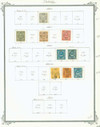
# MCC1464 - 1863-1976 Turkey
Issue Dates: 1865-1976
Scott Catalogue Value: $1,121.10
Mystic Price: $850.00
You Save: $271.10
Large Turkey collection contains approximately 1,200 stamps with 100 album pages. Blend of mint and postally used stamps with many complete sets. The collection begins with #10, the 1-piaster lilac issue of 1865. Includes mint #62 valued at $75 plus a complete mint never-hinged 1954 Compass and Map set. Also #550, the 1917 5-piaster overprinted stamp of 1905 (catalogue value $50).
Back of the Book stamps include Airmail, Military, Newspaper, Official, Postage Due and Semi-postal issues highlighted by #P26 and #P28 (value approximately $362 with minor flaws).
For 16 centuries, Istanbul (formerly Constantinople), Turkey’s capital city, played a major role in world politics. First as capital of the vast Byzantine Empire, and then as capital of the Ottoman Empire, it was the most powerful Islamic empire in history.
Turkey has been referred to as the “crossroads of cultures,” because of the intermingling of ancient tradition and modern influences. The skyline of Turkey suggests a purely ancient city, with spires and domes of mosques and medieval palaces. But on closer examination, the influence of Western culture is apparent. On the streets, women in business suits or designer outfits pass women wearing the traditional long skirts and head coverings. Donkey-drawn carts move among modern automobiles. A person may shop at ancient-style oriental bazaars or western boutiques.
On its European side, Turkey borders Bulgaria and Greece, but most of its land mass is in Asia, where it shares borders with Syria, Iran, Iraq, and the Soviet Union. Nevertheless, politically, as well as culturally, Turkey has incorporated the western philosophy. Turkey had been defeated in World War I and lost much of its former territory. In 1923, Turkish President Kemal Ataturk gathered the remains of the formerly great empire and formed them into a modern republic with a European outlook. He even replaced the difficult Arabic script with the Latin-based alphabet, and the literacy rate increased from 9 percent to 75 percent. In 1988, Turkey applied to join the European Economic Community, and it has been a member of the North Atlantic Treaty Organization since 1950.
Despite the Western influences, Turkey remains solidly Islamic. Of its 52 million people, 99 percent are Muslim, primarily rural people whose lives are deeply rooted in tradition. You can drive through areas where people still pick cotton by hand. And when the call to pray is sounded from the ancient mosques, most Turks will be found kneeling on their prayer rugs, facing Mecca – the holy city of Islam.
Issue Dates: 1865-1976
Scott Catalogue Value: $1,121.10
Mystic Price: $850.00
You Save: $271.10
Large Turkey collection contains approximately 1,200 stamps with 100 album pages. Blend of mint and postally used stamps with many complete sets. The collection begins with #10, the 1-piaster lilac issue of 1865. Includes mint #62 valued at $75 plus a complete mint never-hinged 1954 Compass and Map set. Also #550, the 1917 5-piaster overprinted stamp of 1905 (catalogue value $50).
Back of the Book stamps include Airmail, Military, Newspaper, Official, Postage Due and Semi-postal issues highlighted by #P26 and #P28 (value approximately $362 with minor flaws).
For 16 centuries, Istanbul (formerly Constantinople), Turkey’s capital city, played a major role in world politics. First as capital of the vast Byzantine Empire, and then as capital of the Ottoman Empire, it was the most powerful Islamic empire in history.
Turkey has been referred to as the “crossroads of cultures,” because of the intermingling of ancient tradition and modern influences. The skyline of Turkey suggests a purely ancient city, with spires and domes of mosques and medieval palaces. But on closer examination, the influence of Western culture is apparent. On the streets, women in business suits or designer outfits pass women wearing the traditional long skirts and head coverings. Donkey-drawn carts move among modern automobiles. A person may shop at ancient-style oriental bazaars or western boutiques.
On its European side, Turkey borders Bulgaria and Greece, but most of its land mass is in Asia, where it shares borders with Syria, Iran, Iraq, and the Soviet Union. Nevertheless, politically, as well as culturally, Turkey has incorporated the western philosophy. Turkey had been defeated in World War I and lost much of its former territory. In 1923, Turkish President Kemal Ataturk gathered the remains of the formerly great empire and formed them into a modern republic with a European outlook. He even replaced the difficult Arabic script with the Latin-based alphabet, and the literacy rate increased from 9 percent to 75 percent. In 1988, Turkey applied to join the European Economic Community, and it has been a member of the North Atlantic Treaty Organization since 1950.
Despite the Western influences, Turkey remains solidly Islamic. Of its 52 million people, 99 percent are Muslim, primarily rural people whose lives are deeply rooted in tradition. You can drive through areas where people still pick cotton by hand. And when the call to pray is sounded from the ancient mosques, most Turks will be found kneeling on their prayer rugs, facing Mecca – the holy city of Islam.










